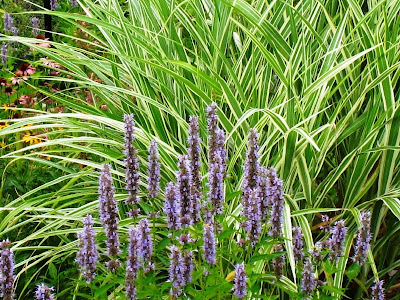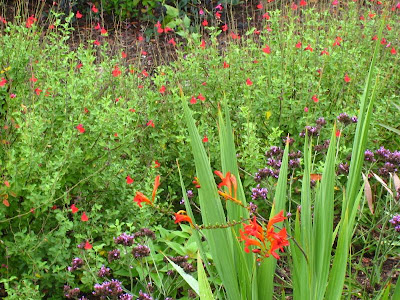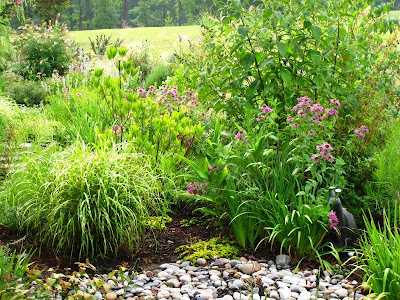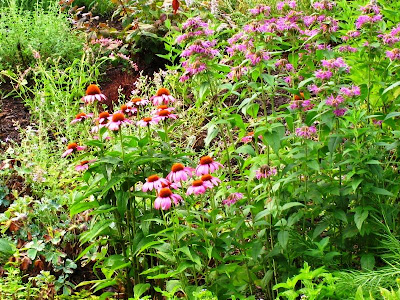Gardens and Deer Traffic Patterns
7:27 PM | Posted by
Donald
We enjoy walking through our flower garden each morning and evening during the spring, summer and fall. Everyday offers a new experience as we see what's in bloom. We see hummingbirds zooming about, goldfinches feeding on seeds as the honeybees, butterflies and dragonflies flitter around the blooms. In the winter, the time spent in the garden is for maintenance and a check on the status of any possible deer damage.
When we created our flower garden, we had to take into account the traffic pattern of the deer. Had we placed our garden in the middle of a long path, it probably would be more difficult to keep the deer out of the garden. We had just a small section of deer path that we needed to block when creating the garden. In other words, we had to re-route the deer traffic around their little short cut to the meadow.
The deer on our property traverse the same paths at about the same time of day, almost everyday. Most every evening, the deer come out of the woods from the east side of our property and cross diagonally through our front meadow. There's also an opening in the woods on the west side where another group exits in the evening to enter the open meadow. It's easy to find 6-8 deer asleep in our meadow every night when our dog goes out just before bedtime.

Food supply is often related to rainfall amounts. We've had a lot of rain this year compared to our drought last year, so there has been plenty of food for the deer outside our garden. We have a manmade water feature (stream and waterfall) that runs inside and outside our fence. During the drought, the deer came up to the stream to drink. With all the rain, they aren't coming into the garden for water. If you have a water source in your garden, you may find deer entering your garden in order to drink when water is scarce.
In April 2007, we had almost no blooms on our Lady Banksia rose that is on the outside of our fence. The deer ate the leaves and blooms. This year, April 2008, the deer apparently had plenty of food in the wild, so the Lady Banksia was in full bloom. In other words, if a plant escapes deer damage one year, it might not in subsequent years.

Our fence is 4 feet high which is easy enough for a deer to jump. However, the garden enclosed by the fence is small and includes our house on two sides. If this fence was surrounding a large, open area (like our meadow), the deer would absolutely jump it. I've been told that deer can jump relatively high fences, so 7 feet is what you'll find with a lot of deer fences. I've also been told that they are less likely to jump WIDE hedges where they can't see a place to land safely.

Where our garden meets the meadow, I try to use aromatic plants that aren't appealing to deer.

I also group shrubs and small trees at places where deer used to cross the meadow before we built the garden. The shrubs block the previous paths. I created new paths for us. I've been told that if deer cannot see a way out, they won't enter into an area without a visible escape route. Creating a sense of enclosure with dense plantings of shrubs, trees, grasses and perennials breaks up a view of an escape route.
The willow tree is also surrounded by shrubs that are unappealing to deer. This was a place where the deer walked before we planted the shrubs as obstructions to the path and their view. Our garden path makes a left turn at the willow, but that isn't obvious to deer.

Buddleia, agastache, lavender and nepeta are great aromatic plants to use. I've never had these even sampled by deer (or rabbits). Planting these at the edges of your garden can help deter deer from entering the garden. If you want smaller edging plants in front of the garden, you can use coreopsis (shown here just starting to bloom this side of the buddleia) or lambs ear (shown to the right behind the coreopsis). The garden is planted thickly along the outer edges, providing no clear entry paths from the meadow.

Lavender, agastache and nepeta have aromatic foliage even when not in bloom. Rosemary is also a good choice. Ornamental grasses, bronze fennel, agastache, nepeta, tall verbena, clumping bamboo and tithonia border the outside of the butterfly garden. From this view, it's also difficult for the deer to see an exit route out of the garden and they are less likely to enter.



The salvia gregii, tall verbena and crocosmia are of no interest to deer, but are loved by hummingbirds and butterflies.

The deer have occasionally strolled up our walkway and down the garden path. Usually this occurs in early spring before the perennials and shrubs are full of foliage.

Once the foliage is up high around the dry streambed, the deer stop crossing through this area. The round rocks are also difficult for them to walk across. Since it's too wide to jump, and because they can't see a landing spot, they no longer come through this area.

Some people have reported deer eating coneflowers even though coneflowers appear on most deer resistant plant lists. I've not had a problem, but I plant my coneflowers with companions such as monarda, which is unappealing to deer. A deer won't touch monarda, in my experience.

The deer would have to walk through a lot of unpleasant foliage and blooms to get to the coneflowers. I've been told that when aromatic plants are nose high (around 30 inches), the deer will tend to move on.

The narrow beds that flank our guest parking area are planted with proven deer resistant plants such as buddleia, lavender, nepeta, hypericum, lambs ear, stachys hummelo, delosperma cooperii, nandina, crape myrtle, cotinus and lantana. The deer will walk through those narrow beds, but there's nothing of interest to eat.

There will always be extreme cases of deer damage, such as deer going up on the porches of homes to eat the plants out of the flower pots. Try to place your garden outside the traffic paths. If you must plant in their paths, do your best to make them go around the area by giving your garden a sense of blocked enclosure. There's a lot of trial-and-error since deer herds have different habits. While waiting for gardens to mature, you will experience more damage with young, tender plants.
We do the best we can! Plant deer resistant plants, obstruct traffic patterns and plant thick, wide groupings. Once fall and winter arrive, there will be more browsing among the evergreens as the deer look for food. When food becomes really scarce, the deer may try plants that they would normally avoid. If there is some damage in winter, but the plants still bounce back to perform beautifully without damage during the spring and summer, then I consider the plant to be deer tolerant.
Story and photos by Freda Cameron
When we created our flower garden, we had to take into account the traffic pattern of the deer. Had we placed our garden in the middle of a long path, it probably would be more difficult to keep the deer out of the garden. We had just a small section of deer path that we needed to block when creating the garden. In other words, we had to re-route the deer traffic around their little short cut to the meadow.
The deer on our property traverse the same paths at about the same time of day, almost everyday. Most every evening, the deer come out of the woods from the east side of our property and cross diagonally through our front meadow. There's also an opening in the woods on the west side where another group exits in the evening to enter the open meadow. It's easy to find 6-8 deer asleep in our meadow every night when our dog goes out just before bedtime.

Food supply is often related to rainfall amounts. We've had a lot of rain this year compared to our drought last year, so there has been plenty of food for the deer outside our garden. We have a manmade water feature (stream and waterfall) that runs inside and outside our fence. During the drought, the deer came up to the stream to drink. With all the rain, they aren't coming into the garden for water. If you have a water source in your garden, you may find deer entering your garden in order to drink when water is scarce.
In April 2007, we had almost no blooms on our Lady Banksia rose that is on the outside of our fence. The deer ate the leaves and blooms. This year, April 2008, the deer apparently had plenty of food in the wild, so the Lady Banksia was in full bloom. In other words, if a plant escapes deer damage one year, it might not in subsequent years.

Our fence is 4 feet high which is easy enough for a deer to jump. However, the garden enclosed by the fence is small and includes our house on two sides. If this fence was surrounding a large, open area (like our meadow), the deer would absolutely jump it. I've been told that deer can jump relatively high fences, so 7 feet is what you'll find with a lot of deer fences. I've also been told that they are less likely to jump WIDE hedges where they can't see a place to land safely.

Where our garden meets the meadow, I try to use aromatic plants that aren't appealing to deer.

I also group shrubs and small trees at places where deer used to cross the meadow before we built the garden. The shrubs block the previous paths. I created new paths for us. I've been told that if deer cannot see a way out, they won't enter into an area without a visible escape route. Creating a sense of enclosure with dense plantings of shrubs, trees, grasses and perennials breaks up a view of an escape route.
The willow tree is also surrounded by shrubs that are unappealing to deer. This was a place where the deer walked before we planted the shrubs as obstructions to the path and their view. Our garden path makes a left turn at the willow, but that isn't obvious to deer.

Buddleia, agastache, lavender and nepeta are great aromatic plants to use. I've never had these even sampled by deer (or rabbits). Planting these at the edges of your garden can help deter deer from entering the garden. If you want smaller edging plants in front of the garden, you can use coreopsis (shown here just starting to bloom this side of the buddleia) or lambs ear (shown to the right behind the coreopsis). The garden is planted thickly along the outer edges, providing no clear entry paths from the meadow.

Lavender, agastache and nepeta have aromatic foliage even when not in bloom. Rosemary is also a good choice. Ornamental grasses, bronze fennel, agastache, nepeta, tall verbena, clumping bamboo and tithonia border the outside of the butterfly garden. From this view, it's also difficult for the deer to see an exit route out of the garden and they are less likely to enter.



The salvia gregii, tall verbena and crocosmia are of no interest to deer, but are loved by hummingbirds and butterflies.

The deer have occasionally strolled up our walkway and down the garden path. Usually this occurs in early spring before the perennials and shrubs are full of foliage.

Once the foliage is up high around the dry streambed, the deer stop crossing through this area. The round rocks are also difficult for them to walk across. Since it's too wide to jump, and because they can't see a landing spot, they no longer come through this area.

Some people have reported deer eating coneflowers even though coneflowers appear on most deer resistant plant lists. I've not had a problem, but I plant my coneflowers with companions such as monarda, which is unappealing to deer. A deer won't touch monarda, in my experience.

The deer would have to walk through a lot of unpleasant foliage and blooms to get to the coneflowers. I've been told that when aromatic plants are nose high (around 30 inches), the deer will tend to move on.

The narrow beds that flank our guest parking area are planted with proven deer resistant plants such as buddleia, lavender, nepeta, hypericum, lambs ear, stachys hummelo, delosperma cooperii, nandina, crape myrtle, cotinus and lantana. The deer will walk through those narrow beds, but there's nothing of interest to eat.

There will always be extreme cases of deer damage, such as deer going up on the porches of homes to eat the plants out of the flower pots. Try to place your garden outside the traffic paths. If you must plant in their paths, do your best to make them go around the area by giving your garden a sense of blocked enclosure. There's a lot of trial-and-error since deer herds have different habits. While waiting for gardens to mature, you will experience more damage with young, tender plants.
We do the best we can! Plant deer resistant plants, obstruct traffic patterns and plant thick, wide groupings. Once fall and winter arrive, there will be more browsing among the evergreens as the deer look for food. When food becomes really scarce, the deer may try plants that they would normally avoid. If there is some damage in winter, but the plants still bounce back to perform beautifully without damage during the spring and summer, then I consider the plant to be deer tolerant.
Story and photos by Freda Cameron
Labels:
deer resistant
Subscribe to:
Post Comments (Atom)
Categories
- artists
- Asclepias
- Asclepias incarnata
- book review
- butterfly garden
- Container garden
- cottage garden
- Deer
- deer resistant
- drought and xeric
- environment
- Europe
- favorite accent
- favorite combination
- Flower
- flower bulbs and seeds
- food
- fragrance garden
- Garden
- garden design
- garden inspiration
- Gardens
- Gravel
- gravel garden
- home
- Home and Garden
- Hunger Games
- Irises
- Japanese iris
- Leaf
- Little Lime
- meadow
- Monarch
- Monarch Butterflies
- Monarch Butterfly
- Monarda
- Monet
- musings
- North Carolina
- nursery review
- Pest and Disease Control
- Plant
- plant care
- Plants A-F
- Plants G-L
- Plants M-Z
- Public
- Purple milkweed
- rabbit resistant
- Recreation
- rose_campion
- seasons
- Shopping
- Shrub
- sources
- Stemware
- Sweet pea
- technology
- travel
- United States
- Wayside
- wildlife
- Wine
Archive
-
▼
2008
(109)
-
▼
December
(29)
- Top Ten Signs That You Are A Plant-Obsessed Gardener
- The Garden through 2008
- A Variety of Garden Paths
- In the Beginning: The Deer Resistant Garden
- Pretty Perennial Foliage (After the Flowers)
- Foliage Combinations in the Perennial Garden
- In the Kitchen: Scones for a Brunch or a Tea
- In the Kitchen: Savory Gouda Bites
- In the Kitchen: Sour Cream Pound Cake
- Garden Inspiration: French Garden in the Dordogne
- Evergreen Gold in the Garden
- Garden Inspiration: Farmland to Flowers
- Organizing Photos with Keywords
- All Creatures Great and Small
- Blogger's Block
- Garden Plants: Best Performance in 2008
- Art in the Garden: The Pottery of Betty Owen
- Winter Wonders, Weeds and Warm Weather
- Garden Inspiration: Karesansui Style
- Meet Harold, Our Neighborhood Heron
- A Sustainable Tabletop Christmas Tree
- Blogging for Happiness
- Where Have All the Frobel Flowers Gone?
- Perennial Edger: Hardy Geranium
- Seedy Friends Show Up for the Holidays
- Let the Winter Sun Shine on Me (and My Garden)
- Scabiosa Blooms in Winter
- Flummoxed by Phlox
- Gardens and Deer Traffic Patterns
-
▼
December
(29)
Powered by Blogger.
Popular Posts
-
By Freda Cameron Although the weather has passed for planting, this is a great time to plan a garden with the children in your family. Durin...
-
George Washington's Mount Vernon is a reminder of the self-sufficiency of farms of historical significance. Did you know that Washingto...
-
Coreopsis ' Star Cluster ' in bloom with companions Eucomis 'Sparkling Burgundy' ( foliage left) echinacea (multiple...
-
The image of a table laden with a bountiful harvest isn't just for Thanksgiving. Local farmers' markets and Community Supported Agri...
-
There are few plants in the garden that are virtually maintenance-free. My favorite foliage plant is carex hachijoensis 'Evergold' ...
-
I tried to make a garden plan when I spread the soil in fall 2006 to create the outer gardens. I researched and researched the right plant...
-
Katie and the Giant Cabbage The idea for Katie’s Krops began with a 9 year old girl and a 40 pound cabbage. In 2008 Katie brought home a ti...
-
These "green" disfigured coneflowers were removed and destroyed. I didn't plant any new " green bloom " echinace...
-
May I see your identification please? Theft comes in many forms and recently garden bloggers have discovered that there are bad guys who wi...
-
By Freda Cameron What is the process of working with a professional garden designer? I asked this question at a local garden center that ha...










0 comments:
Post a Comment